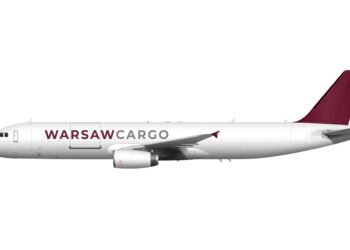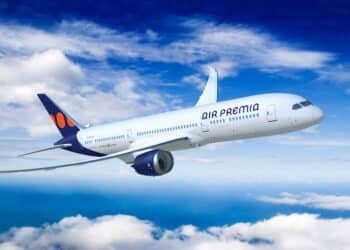China Airlines’ Eddy Liu is 2020’s Air Cargo Executive of the Year
There is a saying that goes something along these lines: The best way to make a small fortune with an airline is to start with a large fortune. While it may be a stretch to say that the best way to make a small fortune with an airline in 2020 is to fly cargo, airfreight has undoubtedly been thrust squarely into the limelight this year — both within and outside the industry — and has been the main source of income for carriers since March.
Cargo executives and teams at all airlines deserve commendation for shouldering the responsibility of keeping their companies and the world afloat in 2020. But few have done so as spectacularly as Taiwan-based China Airlines. Led by Vice President Eddy Liu, the carrier’s cargo division not only achieved triple-digit year-over-year increases in revenue for two consecutive quarters, but actually made a small fortune for the company — and saved it from the red in the second quarter.
For this admirable performance, the readers and editors of Air Cargo World have named Liu the Air Cargo Executive of the Year for 2020.
Early challenges
In January and February this year, before COVID-19 was even declared a pandemic, signs of trouble for the aviation industry had already been brewing in many Asian markets, recalls Liu. In an effort to contain the virus outbreak, factory closures in China were prolonged due to an extended Chinese New Year break, leading to decreased air freight traffic.
“Then, all of a sudden, the market picked up, particularly out of mainland China,” said Liu. “Around the end of March, we sensed a surge in urgent demand for air cargo and we felt we needed to seize this good opportunity. We started to rework a full-scale freighter network into mainland Chinese cities like Guangzhou (CAN), Chongqing (CKG), Nanjing (NKG), Zhengzhou (CGO) and Shanghai (PVG). From then until the peak in May, we managed to secure a lot of business, much of which consisted of personal protective equipment (PPE) charters.”
But at the time, Taiwan’s Centers for Disease Control had already instituted strict entry restrictions and quarantine requirements that posed challenges to how China Airlines could dispatch its crews. To deal with that, Liu and his team simplified the freighter schedule. For instance, China Airlines used to fly its freighters to Frankfurt (FRA), Amsterdam (AMS) and Luxembourg (LUX) in Europe, but to smooth out its crew operations, the carrier suspended FRA and AMS. On the trans-Pacific lane, Miami (MIA) and Houston (IAH) were also suspended so the airline could divert more resources to Los Angeles (LAX) and Chicago (ORD).
A ‘coach-style’ leader
Juggling freighter deployment is something Liu has plenty of hands-on experience doing in such roles as: general manager of cargo marketing and planning; assistant vice president of cargo sales, marketing and services; general manager of America cargo sales and services; and general manager of Europe cargo sales and services.
In fact, according to a colleague, in preparation for the launch of a new freighter route, Liu once submitted all the application documents to Taiwan’s Civil Aeronautics Administration (CAA) in person, in order to ensure the relevant approvals were granted so the target timeline could be met.
Liu’s team describes his leadership style as akin to that of a coach; he draws on his own experience to mentor his team members, identifying the strengths of each employee to improve collaboration. Bringing together complementary strengths was the primary consideration behind Liu’s proposition to merge the cargo sales and marketing with the cargo services units when he was appointed VP of cargo in 2016.
Passenger freighters
Even with a large freighter fleet consisting of eighteen 747-400Fs, China Airlines has had to supplement its cargo capacity this year by using passenger aircraft to carry cargo only, as is the case with all major airlines.
Unlike fellow Taiwan-based carrier EVA Air, however, China Airlines has not reconfigured any aircraft. EVA partially removed seats from the passenger cabin of one of its 777-300ERs in May and began flying it in June after regulatory approval from the CAA. And while the CAA green-lighted the use of seats for cargo in late April, China Airlines only does so on select flights, simply because of the main-deck space it is already able to offer. EVA Air, by contrast, only has five 777Fs.
According to Liu, China Airlines has averaged around 1,100 cargo-only flights per month with its A330-300s, A350-900s and 777-300ERs from the beginning of the second quarter, serving mainly intra-Asia routes, the U.S. West Coast and Oceania.
With Sydney (SYD) and Auckland (AKL), for example, China Airlines previously operated around seven to ten passenger flights a week, but that has now grown to eighteen to twenty-one, all carrying just freight. Notably, China Airlines was among the first round of carriers granted contracts under the New Zealand government’s International Air Freight Capacity scheme to carry goods to and from the country at a time when all international flights had been cut.
But LAX easily takes the crown when it comes to China Airlines’ cargo-only operations; on most afternoons, it wouldn’t be unusual to see at least three or four A350s and 777s in the carrier’s plum-blossom livery on the ground at the same time, leaving aside the two or three daily 747 freighters that visit the airport.
“There is a lot of demand to and from LAX, so we’ve deployed more 777-300ERs there,” said Liu. “Even before the pandemic, we already had a significant presence, but we’re now flying up to six or seven times a day with our passenger aircraft in addition to our 747-400Fs. We expect to maintain a similar number of cargo-only passenger flights for at least the next few months before passenger travel demand recovers.”
Reaping the benefits
With its freighter fleet operating a total of around 60 to 70 weekly intra-Asia flights and 48 weekly long-haul flights, daily utilization is at a record fifteen block hours per aircraft. “That’s very high and challenging to sustain, but even with all this capacity we have, it’s not enough to satisfy the demand from all our customers,” Liu said. “In a way, that allows us to be selective, but I need to find the right balance. While high-yielding charters are good, I also need to think about our long-term customers and how we maintain these cooperative relationships.”
That strategy is clearly working out well. After a slight dip to 1.25 billion FTKs in the first quarter, China Airlines’ cargo traffic steadily rose to 1.50 billion FTKs in the second quarter and again to 1.74 billion in the third, as most airlines saw their cargo traffic head in the other direction. Even more impressively, China Airlines’ cargo business performed so well in Q2 that it resulted in an overall profit for the group of $83.9 million. Cargo revenue jumped 115.5% year on year to $797 million and saved the company from a net loss despite passenger revenue plunging by 95% compared to a year ago.
That profit was in stark contrast to the net loss of $15.1 million in the first quarter of 2019, and the $129 million net loss in Q1 of 2020. But another similar performance by Liu and his team in Q3 this year was unfortunately not enough to save China Airlines from a quarterly net loss.
Among major combination carriers, China Airlines leads the pack in terms of the share of revenue derived from cargo. In 2019, China Airlines’ cargo activities contributed to approximately 31% of the group’s overall transport-related revenue, whereas the next four highest airlines — Asiana Airlines, Korean Air, Cathay Pacific and Qatar Airways — hovered at around 23% to 25%.
Liu notes not just the size of his company’s freighter fleet, but its proportion relative to the passenger fleet; as of late November, China Airlines had 18 freighters and just 64 passenger aircraft. Most other scheduled airlines that operate freighters tend to have comparatively large numbers of passenger aircraft.
Fleet development
Yet the freighter fleet is set to grow further. In July 2019, China Airlines firmed up an order for three 777Fs and two months later finalized another three. The first frame arrived in Taipei (TPE) on Dec. 1, with a second due before the end of the year.
Liu had previously told Air Cargo World that the 747Fs would be phased out one by one with the arrival of each 777F; that is no longer the case, given the expected slow recovery of the passenger market and continuing demand for cargo capacity.
“We have changed our planning on that and will now keep all our 747s, which means that our freighter fleet will reach 21 aircraft next year: eighteen 747s and three 777Fs,” he said. “Our next order of three 777Fs will start arriving in 2022. We’re currently planning to keep all our aircraft even then, so we will have 24 freighters.”
He added that he and his team have also been evaluating what to do with two other 747Fs that have been stored in Victorville (VCV) since 2012.
While the arrival of the 777F heralds a new chapter for China Airlines Cargo, Liu is partial to the 747, which had a place at the airline in the form of the -200F even when he joined almost 35 years ago. “The 747 has been in the industry for so many years, and we still very much enjoy operating it,” he said. “One advantage of the 777F is the wider side cargo door, but the internal contour is not as friendly as the 747F. My ideal freighter would be a new twin-engine freighter with the body of the 747, but with no next-generation replacement, we and other cargo operators have no choice but to take 777Fs or even 777-300ER conversions in the future.”
The road ahead
When they enter service in 2021, the 777Fs will allow China Airlines to restore more of its network but will also bring opportunities for expansion. “We’ve been very flexible in adjusting our freighter schedules, depending on the changing demand and yield,” said Liu. “The trans-Pacific is our niche market and will still be a major focus for us. In the U.S., we’re studying whether Portland would conflict with our Seattle flights, but apart from that, we’re also thinking about expanding our freighter operation in Oceania and Europe.”
Looking a little closer to home, Liu believes in the long-term potential of the Asia-Pacific region and what that means for China Airlines. “Regardless of trade wars, many main manufacturing bases will be still be in Asia, which has become a mature area,” he said. “Some production lines may shift to Southeast Asia or even to Taiwan, but we have extensive coverage of these regions so can be very reactive to any changes in market demand. As long as global merchandise trade goes on, we believe airfreight demand in the region will keep on growing, with e-commerce, electronics, garments, and auto parts being bright spots.”
In anticipation of that growth, and to manage and enhance China Airlines’ current sales activities, Liu’s cargo department has recently completed an internal reorganization, strengthening sales and revenue management, strategy and interline cooperation. The department will also, for the first time in a while, expand its relatively lean sales and marketing team by almost 50%.
“Top management fully understands and appreciates the importance of the cargo team,” said Liu. “I’m happy to say I get a lot of support from them, especially now that cargo is playing such a crucial role in helping to sustain the operation and cash flow of the whole company.”




